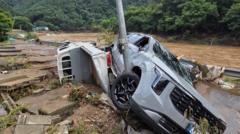At least 14 individuals have tragically lost their lives due to devastating floods and landslides in South Korea, a situation precipitated by days of relentless rainfall, according to reports from the country's disaster management office. Rescue teams are working tirelessly, and there are growing concerns that the death toll may climb, as 12 individuals remain unaccounted for.
Shocking footage reveals the frantic efforts of residents navigating through thick sludge in the resort town of Gapyeong, which has been severely impacted by landslides. Many are making their way to evacuation centers across damaged bridges. In a particularly horrific incident, an entire village in the Chungcheon region became engulfed in earth and wreckage due to a landslide on Saturday.
Since the torrential rains began earlier in the week, nearly 10,000 people have fled their homes. Reports indicate that over 41,000 households are currently without power. Although the rainfall has started to ease in the hardest-hit central and southern regions, forecasts predict further precipitation for Seoul and surrounding northern areas.
The economic impact includes extensive damage to thousands of homes, infrastructure, and agricultural land, compounded by the loss of livestock. Most fatalities occurred in the south, particularly in Sancheong county, where six individuals died and seven are still missing. The northern mountainous areas near Seoul reported additional casualties.
On Sunday, two fatalities were confirmed in Gapyeong, with four others missing due to a landslide that destroyed residential properties. Teams have successfully rescued 63 individuals, while approximately 285 residents have evacuated the affected areas, as per the Gyeonggi Province Fire Department's updates. Experts have issued significant landslide alerts across several regions of the nation.
In response to this escalating disaster, the South Korean government has activated a multi-agency recovery initiative aimed at addressing the immediate needs of affected communities and managing the ongoing crisis.


















